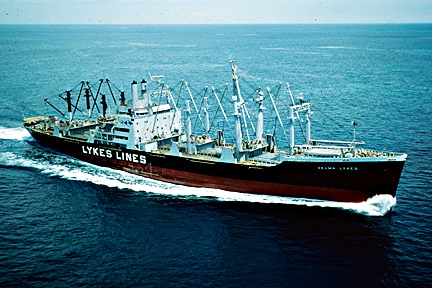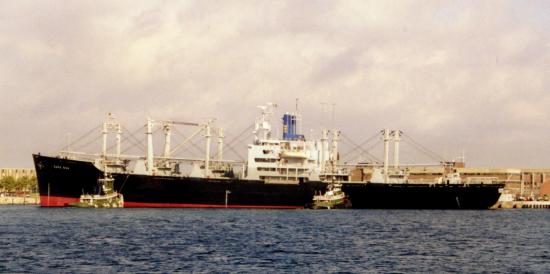The Training Ship Enterprise began life as the six hatch general cargo ship Velma Lykes, built for the Lykes Brothers Steamship Company by Avondale Shipyards near New Orleans, Louisiana in 1967. Velma Lykes was the tenth of twelve ships in the Gulf and Far East Clipper Ship class (MARAD design C4-S-66a) built between 1965 and 1968, and was assigned the Avondale yard hull number 1069, and the Maritime Administration Hull number 182. Other ships in this class were the Louise Lykes, Elizabeth Lykes, Ruth Lykes, Mason Lykes, Mallory Lykes, Stella Lykes, Howell Lykes, Frederick Lykes, Genevieve Lykes, Letitia Lykes and Dolly Turman. The cost to build the Velma Lykes was about $10.5 million, and more than half the cost was covered by MARAD subsidy.
The Lykes Brothers Steamship Company traces its roots to the Civil War, when Dr. Howell T. Lykes collected and delivered cattle to confederate soldiers in Florida. After the war, Dr. Lykes raised cattle and citrus fruit and shipped them to Cuba. Dr. Lykes’ seven sons continued and expanded the cattle and shipping business, and formed the forerunner of the present company in 1900. The Lykes Lines tradition of naming their ships after family members dates back to that time, when the brothers named their first ship, a 110 foot long, 75 ton three-masted schooner Doctor Lykes after their father.
Our ship's namesake, Velma Lykes, was the wife of the oldest of the Lykes brothers, Frederick Eugene Lykes, and this was actually the third ship to bear her name. The first Velma Lykes was a 261 foot long, 2,637 gross ton freighter which was built in 1920 and bought by Lykes brothers in 1927. Sadly, this ship was torpedoed and sunk by a German U-boat 20 miles off Puerto Juarez, Mexico on June 4, 1942 with 15 crew members killed. The second Velma Lykes was an 8,256 gross ton C-2 freighter built in 1945 which completed 103 voyages for Lykes Brothers before she was scrapped in Tiawan in 1971. In later years, two other ships, the SS Jean Lykes, and the chartered vessel MV Warnemunde both briefly carried the Velma Lykes name.
Figure 1 S.S. Velma Lykes

The Gulf Clipper class was designed to carry general and break bulk cargoes in six holds from ports in the Gulf of Mexico to the Far East, including Japan, Singapore, Hong Kong, Korea, Tiawan, Maylasia and the Philipeans. Typical cargos included food, cotton, machinery, consumer items, and industrial chemicals. The ship also carried military cargos to South Vietnam during the Vietnam war.
The class was notable at the time of construction for the level and sophistication of the engine room automation. These were the first ships to have fully automated startup and shutdown of the turbogenerators and feed pumps. Previous automation systems required the engineer to monitor each step of the start-up process and indicate when it was safe to proceed. With the sequential starting system, all start-up and safety checks were performed by electronic logic and the operational status was indicated by lights on the engine room console. The Gulf Clipper ships were also equipped with bridge control of the main engine speed, and a data logging system which printed out plant operating information such as temperatures, pressures, and RPM on a teletype machine in the engine room. With this level of automation, the US Coast Guard was able to certify the ship to operate with a two man engineering watch, rather than the traditional three, significantly reducing operating costs. Hatch covers operated with rotary hydraulic motors, and an 800 Horsepower bow thruster were other novel features of the class.
The Velma Lykes made history in 1979 when she became the first US flag vessel to call on the mainland Chinese port of Whampoa since the Chinese communist revolution.
In 1985 Velma Lykes, along with four sister ships, was acquired by MARAD and upgraded for use in the Ready Reserve Force (RRF). The RRF is a fleet of government-owned, militarily useful, merchant ships within the National Defense Reserve Fleet which is available for rapid breakout and use. It was at this time that the ship was renamed the Cape Bon, after a World War II troop carrier.
Cape Bon is the most northerly point in Africa, on the coast of Tunisia and near the island of Sicily. Near this cape on December 13, 1941, the Italian Navy cruisers Di Giussano and the Da Barbiano were sunk in a night action by British Naval forces forewarned with top secret ULTRA intelligence from British code breakers, while they were attempting to deliver fuel and food from Palermo to Axis forces in Tripoli, Libya. Over 900 Italian sailors lost their lives.
After entering the RRF, the ship was in lay-up in MARAD's Suisun Bay Reserve Fleet near San Francisco, except for brief breakouts, and was maintained by Marine Transport Lines and Interocean Ugland Management Corp. of Voohees, N.J. However in 1991, the Cape Bon along with 75 other RRF vessels was activated for service in Operations Desert Shield/Storm during the Persian Gulf Crisis.
In 1998, an ultrasonic survey found extensive corrosion in the hull and watertight bulkheads in the academy's training vessel Patriot State, and the ship was declared unseaworthy. Rather than undertake the extensive repairs required to restore her seaworthiness, the decision was made to find a replacement ship and the Cape Bon was selected as the most suitable available vessel in the reserve fleet. Although the Patriot State would no longer serve the academy underway, MARAD granted permission for MMA cadets to remove machinery for use as static training aids, and the ship's high pressure turbine, feed pump, heat exchangers, main throttle board, and more can still be found in the MMA marine engineering laboratories. On November 28, 1999 the Patriot State was towed away from the academy and she is now laid up in the James River in Virginia, and though no longer training MMA cadets, she is still used for anti-terrorist training by Navy SEALS and her ship’s bell still sounds above Blinn Hall.
In October 1999, President Bill Clinton authorized $25 million for the conversion of the Cape Bon from cargo ship with a 44-man crew into a training ship for 600 cadets, officers, and crew. The following December the ship was steamed to the MMA campus for the first time, and over the next year MARAD naval architects, in consultation with MMA representative Captain Tom Bushy developed plans for the conversion. With the plans and preliminary work completed, the ship was towed from the Academy to Bender Ship Repair in Mobile, Alabama on January 1, 2001 to begin the conversion work.
The work required to convert the cargo ship to a training ship was extensive. Of the ship's six holds, only holds No. 1 and 2 remain in their original cargo-carrying configuration. Cadet berthing, laundry, and exercise facilities were installed in 3 and 4 Holds. The Auxiliary Machinery Room was added in 4 Hold to provide hotel services such as potable water, sanitary, air conditioning and electricity from the new Wartsila 8L20 medium speed, heavy fuel diesel generator. New refrigerated and dry storage, classrooms, and labs were installed in 5 Hold. Two cargo oil deep tanks were converted for potable water storage, and 6 Hold was converted into a laboratory and classroom area.
New superstructure was added forward and aft of the original house. The forward superstructure extends over cargo holds 3 and 4, and contains crew and cadet berthing, the sick bay, the ship's library, the computer lab, and offices. The after house extends over cargo holds 5 and 6, and contains new galley and messdeck facilities, and space for future crew and officer berthing. A hover-only helicopter deck was built at the extreme after end of the new superstructure. A 5-ton hydraulic crane was installed aft to assist loading refrigerated and dry stores. Both the forward and after superstructures support new SOLAS-approved lifesaving equipment, including six 76-person, totally-enclosed lifeboats and two rescue boats. The original house and the ship's steam propulsion plant were not extensively modified.
It was originally planned that the conversion would be completed by December 2001, in time for the academy to use the ship for her first cruise in the spring of 2002, but that timetable was not met. Delays extended the conversion an additional ?? months, the $25 million project expanded to over $32 million, and some planned work was eliminated, notably completion of the quarters in the after house. The ship finally arrived back at Buzzards Bay in ????? 2003, in time for its maiden training cruise in January 2004. During the period 1999 - 2003, MMA training cruises were made aboard the TS Empire State, the training vessel of SUNY Maritime College.
The Training Ship Enterprise is now certified by the U. S. Coast Guard as a Public Nautical School Ship, and classed by the American Bureau of Shipping. In addition to serving as the academy's training vessel Enterprise continues to serve the United States as one of two RRF troopships. The ship is maintained in 10-day readiness status, meaning that she can be reactivated and available to embark troops within 10 days of notice to proceed.
The name Enterprise was given to the vessel by MMA President RADM Maurice Bresnehan to honor the first training vessel used by the academy. The original Enterprise was a 185-foot, bark-rigged steam vessel that was loaned to MMA by the Navy, and commissioned in 1893. 110 years later, the new Enterprise is the academy's ninth permanently assigned training ship.

